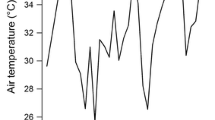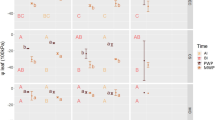Abstract
Long dry seasons or permanent flooding, typical of tropical savannas, severely limit the growth of pasture plants. This study compares the responses of water relations, carbon assimilation and alcohol dehydrogenase (ADH) activity to drought and flooding in four perennial C4 grasses: the tufted or caespitose Hyparrhenia rufa and Andropogon gayanus (CIAT 621) and the stoloniferous Brachiaria mutica and Echinochloa polystachya.
Plants of the four species were subjected to medium term flooding (20–25 days) and moderate drought in a greenhouse. Leaf water potential (Ψ), stomatal conductance (Gs) and photosynthesis rate (Pn) were measured throughout the experiment and ADH activity was measured in flooded and control plants.
Moderate drought produced similar effects in all grasses reducing Gs which caused reduced Pn. Net photosynthesis compensation point was reached at the lowest Ψ in A. gayanus which was considered as the most drought tolerant. The responses to flooding varied across species. Andropogon gayanus and H. rufa showed early stomatal closure without concurrent decrease in Ψ and leaf turgor. This low Gs was responsible of reduced Pn and growth rate. There was a slight increase of Gs in the middle of the flooding period and both grasses recovered pre-stress Gs and Pn after drainage. ADH activity increased markedly only in A. gayanus under flooding suggesting that this grass was the most flood-sensitive. Stomatal aperture, Pn and ADH activity in B. mutica and E. polystachya were not affected by flooding. The higher flood-tolerance in these grasses might be attributed to enhanced oxygen diffusion to the roots through the hollow stolons, development of advantitious rootlets and large aerenchyma in the roots which compensate for the reduction of soil oxygen and permit the maintenance of root activity.
Similar content being viewed by others
References
Anderson, E R 1974 The reaction of seven Cenchrus ciliaris L. cultivars to flooding. Trop. Grassl. 8, 33–123.
Armstrong, W, Justin, S H F W, Beckett, P M and Lythe, S 1991, 57–73. Root adaptation to soil waterlogging. Aquatic Bot. 39, 57–73.
Baruch, Z 1994 Responses to drought and flooding in tropical forage grasses: I. — Production and allocation of biomass, leaf growth and mineral nutrients. Plant and Soil 164, 87–96.
Baruch, Z and Fisher, M J 1991 Factores climáticos y de competencia que afectan el desarrollo de las plántulas de las especies forrajeras. In Establecimiento y renovación de pasturas. Eds. C ELascano and J MSpain. pp 103–142, Centro Internacional de Agricultura Tropical, Cali, Colombia.
Baruch, Z, Ludlow, M M and Davis, R 1985 Photosynthetic responses of native and introduced C4 grasses from Venezuelan savannas. Oecologia 67, 288–293.
Blackman, P G and Davies, W J 1985 Root to shoot communication in maize plants on the effects of soil drying. J. Exp. Bot. 36, 39–48.
Bergmeyer, H U 1974 Methods of enzymatic Analysis. Vol. 4. Academic Press, New York.
Bradford, K J 1983 Involvement of plant growth substances in the alteration of leaf gas exchanges of flooded tomato plants. Plant Physiol. 73, 480–483.
Bradford, K J and Hsiao, T C 1982 Stomatal behavior and water relations of waterlogged tomato plants. Plant Physiol, 70, 1508–1513.
Bradford, M 1976 A rapid and sensitive method for the quantification of microgram quantities of protein utilizing the principle of protein dye binding. Anal. Biochem. 72, 248–258.
Burdick, D M and Mendelssohn, I A 1990 Relationship between anatomical and metabolic responses to soil waterlogging in the coastal grass Spartina patens. J. Exp. Bot. 41, 223–228.
Chapin, F S 1991 Integrated responses of plants to stress. BioScience 41, 29–36.
Crawford, R M 1982 Physiological response to flooding. In Physiological Plant Ecology II. Encyclopedia of Plant Physiology. New Series. Vol. 12B. Eds. O LLange, P SNobel, C BOsmond and HZiegler. pp 453–477. Springer-Verlag, Berlin.
Daubenmire, R 1972 Ecology of Hyparrhenia rufa Nees in derived savanna in NW Costa Rica. J. Appl. Ecol. 9, 11–23.
Davies, W J and Zhang, J H 1991 Root signals and the regulation of growth and development of plants in drying soil. Ann. Rev. Plant Physiol. Plant Mol. Biol. 42, 55–76.
Drew, M C 1992 Soil aeration and plant root metabolism. Soil Sci. 154, 259–268.
Everard, J D, Lecain, D R, Rumpho, M E and Kennedy, R A 1991 Mesictyl root formation in Echinochloa phyllogopon (Poaceae) in relation to root zone aeration. Am. J. Bot. 78, 462–469.
Hook, D D 1984 Adaptations to flooding with fresh water. In Flooding and Plant Growth. Ed. T TKozlowski. pp 265–294. Academic Press, New York.
Humphreys, L R 1980 Environmental Adaptation of Tropical Pasture Plants. Macmillan, New York.
Jackson, M B 1993 Are plant hormones involved in root to shoot communication? Adv. Bot. Res. 19, 103–187.
Jackson, M B and Drew, M C 1984 Effects of flooding on growth and metabolism of herbaceous plants. In Flooding and Plant Growth. Ed. T TKozlowski. pp 47–128. Academic Press, New York.
Jackson, M B and Hall, K C 1987 Early stomatal closure in waterlogged pea plants is mediated by abscisic acid in the absence of foliar water deficits. Plant Cell Environm. 10, 121–130.
Justin, S H and Armstrong, W 1987 The anatomical characteristics of roots and plant response to soil flooding. New Phytol. 106, 465–496.
Kawase, M 1981 Anatomical and morphological adaptation of plants to waterlogging. Hortscience 16, 8–12
Ludlow, MM 1980 Stress physiology in tropical pasture plants. Trop. Grassl. 14, 136–145.
Medina, E and Motta, N 1990 Metabolism and distribution of grasses in tropical flooded savannas in Venezuela. J. Trop. Ecol. 6, 77–89.
Naidoo, G and Mundree, S G 1993 Relationships between morphological and physiological responses to waterlogging and salinity in Sporobolus virginicus (L.) Kunth. Oecologia 93, 360–366.
Pezeshki, S R, DeLaune, R D and Lindau, C W 1988 Interaction among sediment anaerobiosis, nitrogen uptake and photosynthesis of Spartina alterniflora. Physiol. Plant. 74, 561–565.
Ponnamperuma, E N 1984 Effects of flooding on soils. In: Flooding and Plant Growth. Ed. T TKozlowski. pp 265–294. Academic Press, New York.
Sarmiento, G 1984 The ecology of Neotropical savannas. Harvard Univ. Press, Cambridge, Mass.
Sojka, R E 1992 Stomatal closure in oxygen stressed plants. Soil Sci. 154, 269–280.
Thomson, C J, Armstrong, W, Waters, I and Greenway, H 1990 Aerenchyma formation and associated oxygen movement in seminal and radial roots of wheat. Plant Cell Environm. 13, 395–404.
Toledo, J M and Fisher, M J 1989 Aspectos fisiológicos de Andropogon gayanus y su compatibilidad con leguminosas forrajeras. In Andropogon gayanus Kunth un pasto para suelos ácidos del trópico. Eds. J MToledo, RVera and CLascano. pp 69–104. CIAT, Cali, Colombia.
Wadman-van Schravendijk, S H and vanAndel, O M 1985 Interdependence of growth water relations and absicic acid level in Phaseolus vulgaris during waterlogging. Physiol. Plant. 63, 215–220.
Wenkert, W, Fausey, N R and Watters, H D 1981 Flooding responses in Zea mays L. Plant and Soil 62, 351–366.
Wilson, J R, Ludlow, M M, Fisher, M J and Schulze, E D 1980 Adaptation to water stress of the leaf water relations of four tropical forage species. Aust. J. Plant Physiol. 7, 207–220.
Yu, P T, Stolzy, L H and Letey, J 1969 Survival of plants under prolonged flooded conditions. Agron. J. 61, 844–847.
Author information
Authors and Affiliations
Rights and permissions
About this article
Cite this article
Baruch, Z. Responses to drought and flooding in tropical forage grasses. Plant Soil 164, 97–105 (1994). https://doi.org/10.1007/BF00010115
Received:
Accepted:
Issue Date:
DOI: https://doi.org/10.1007/BF00010115




